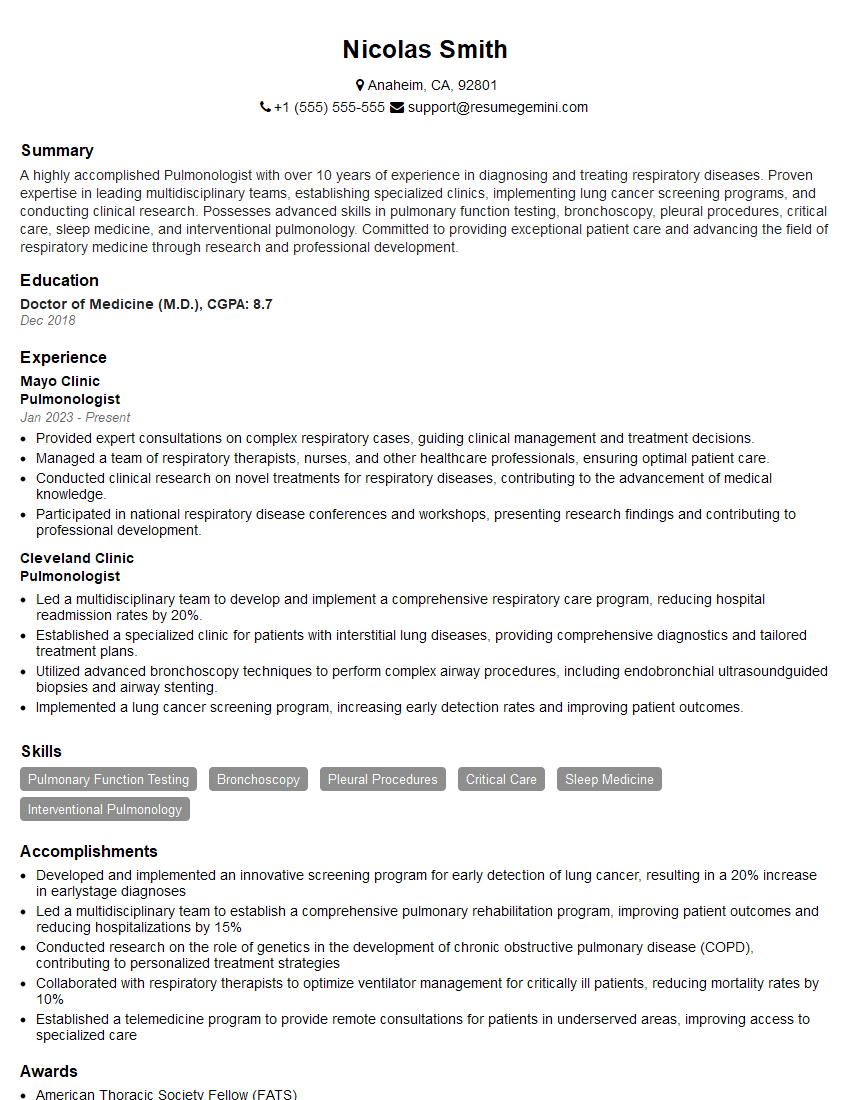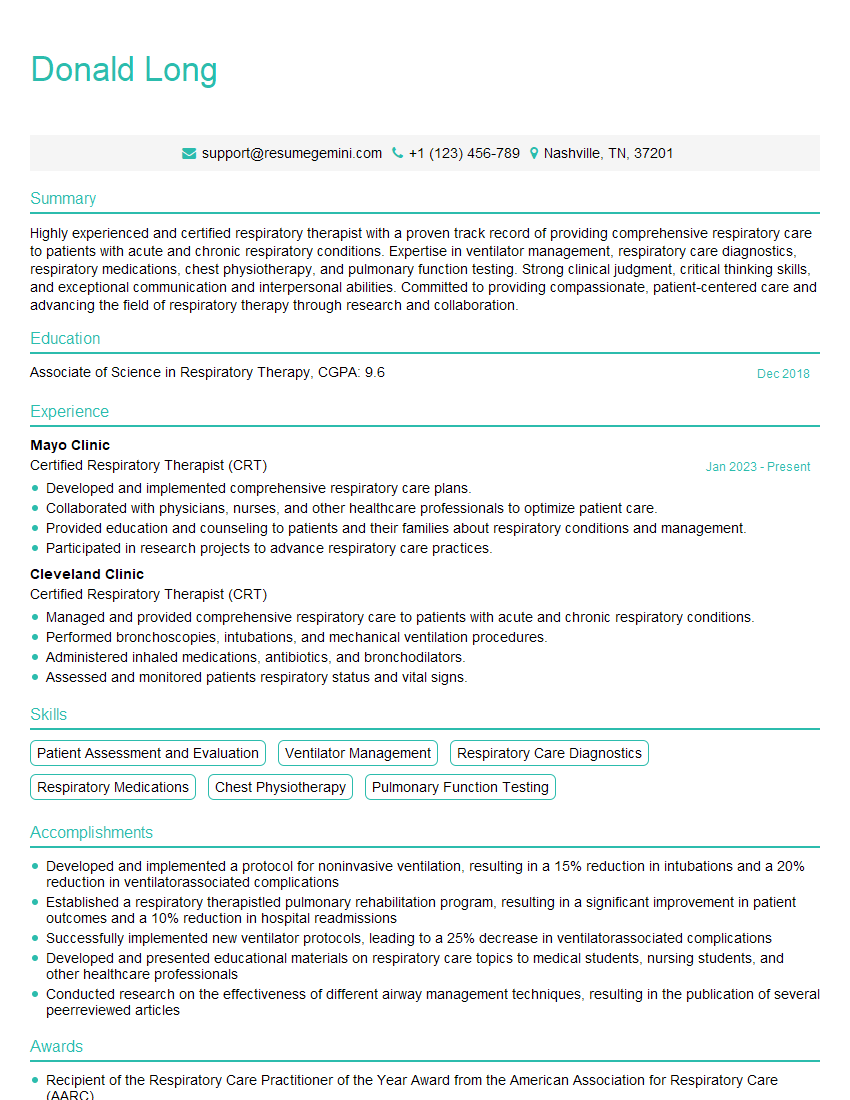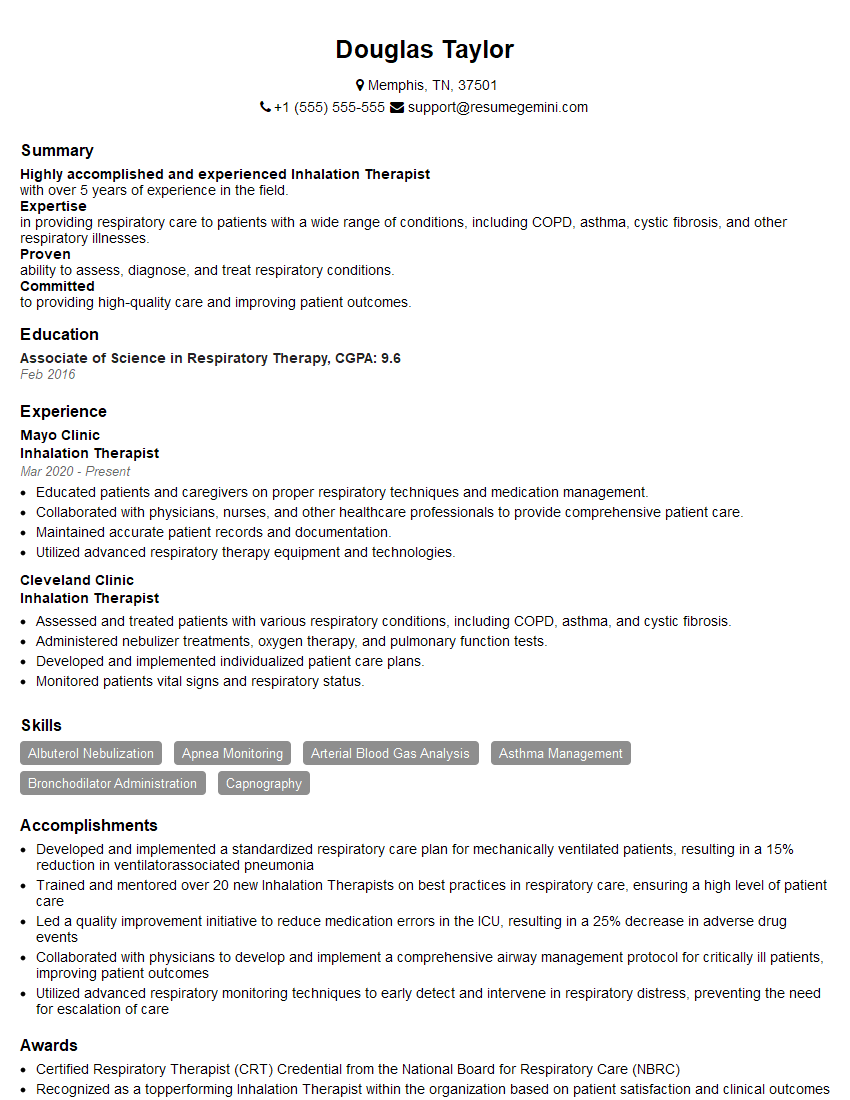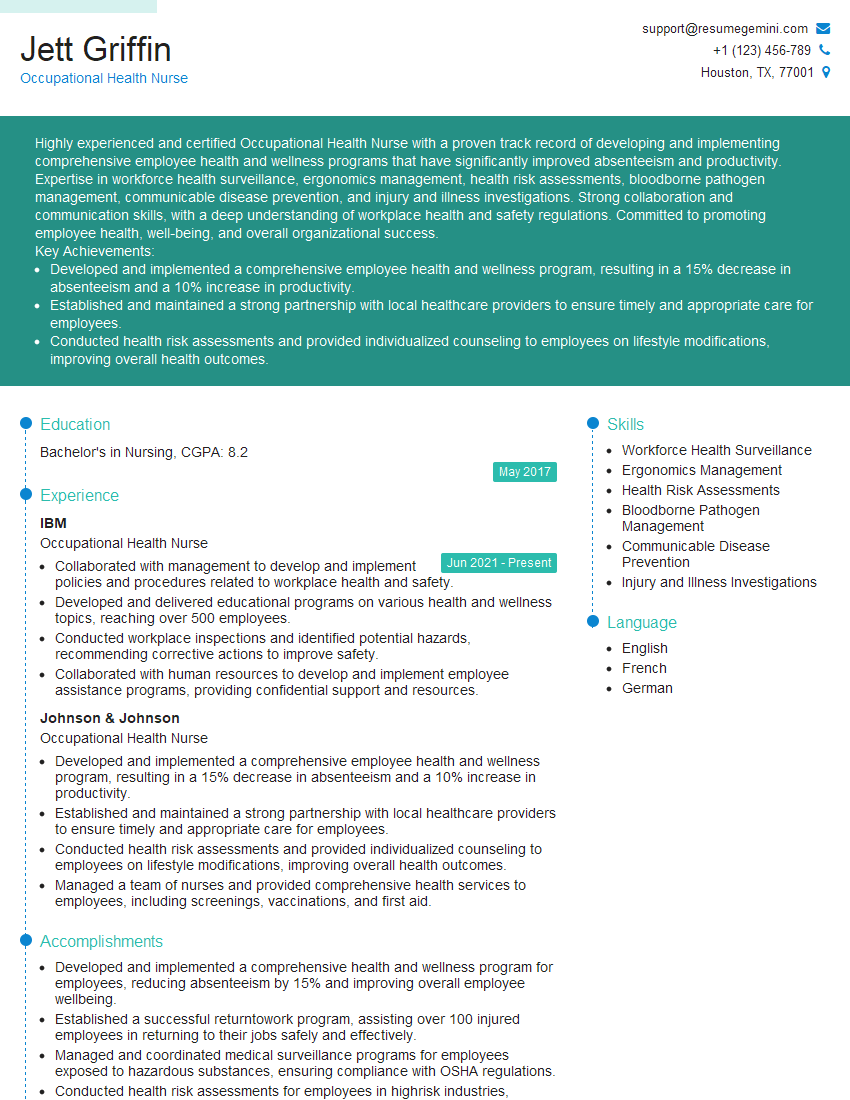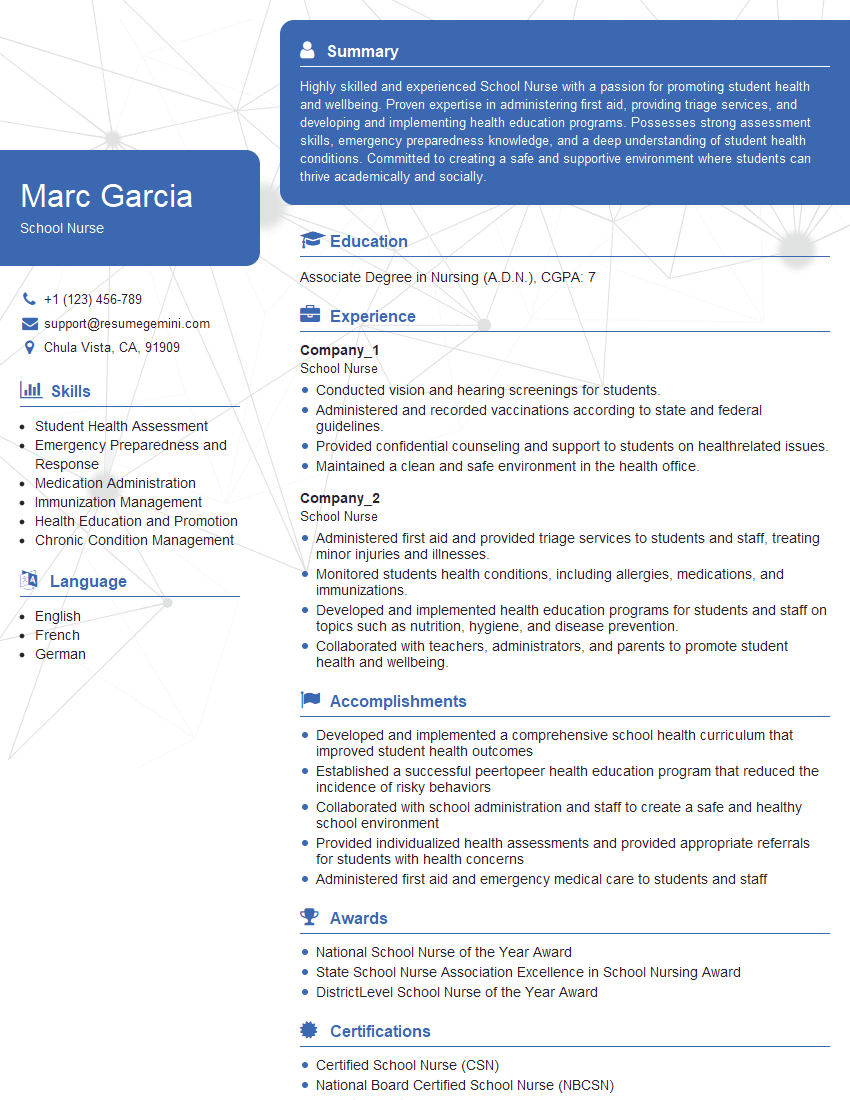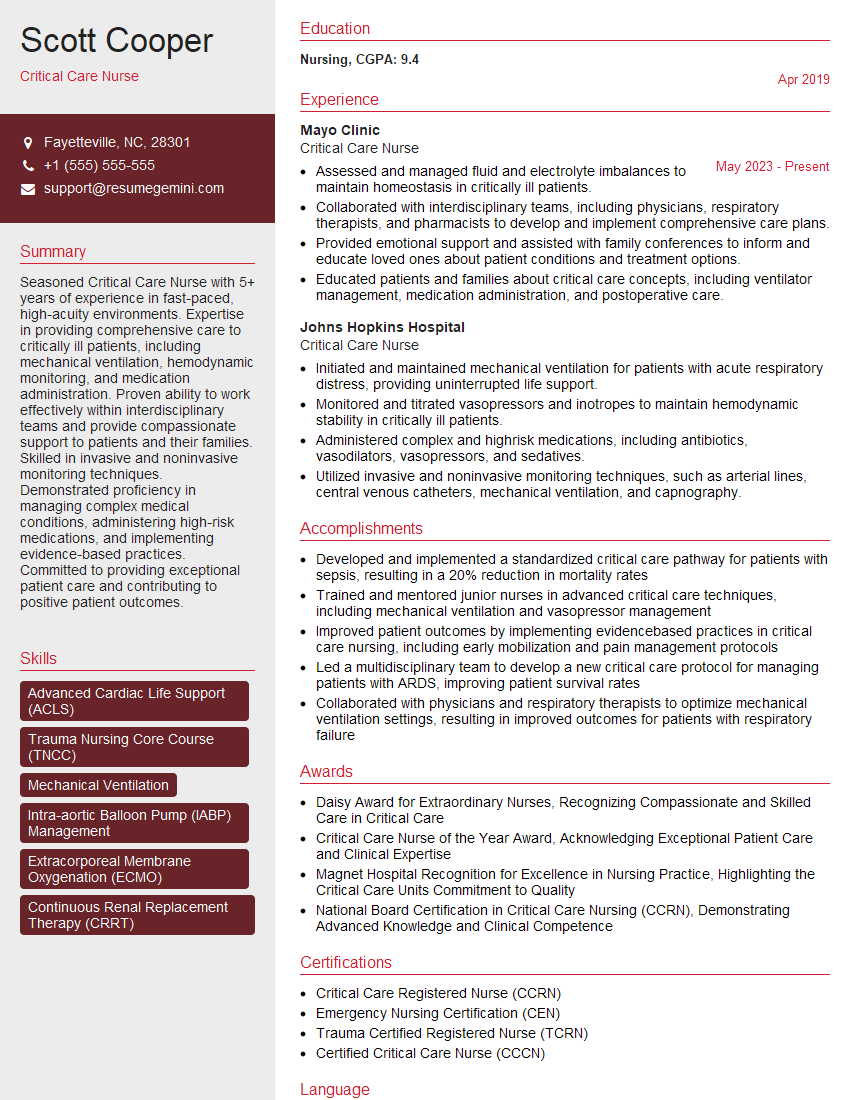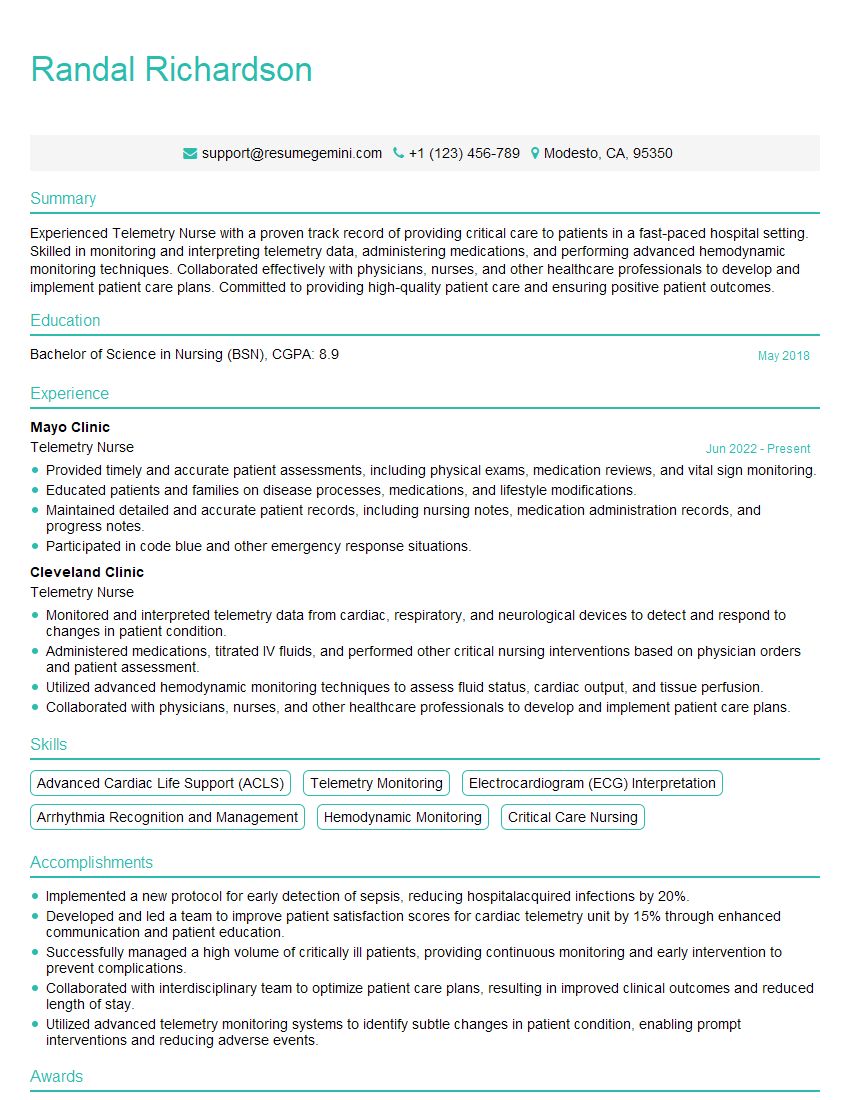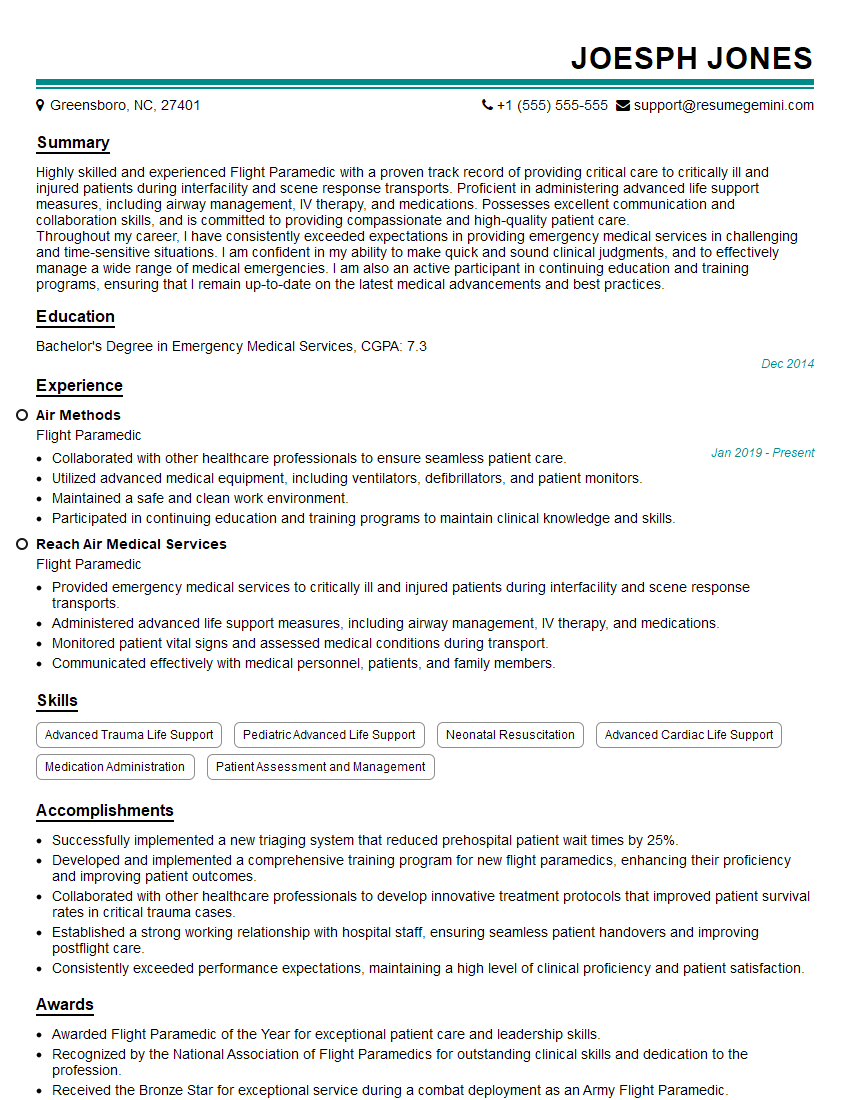Are you ready to stand out in your next interview? Understanding and preparing for Albuterol Nebulization interview questions is a game-changer. In this blog, we’ve compiled key questions and expert advice to help you showcase your skills with confidence and precision. Let’s get started on your journey to acing the interview.
Questions Asked in Albuterol Nebulization Interview
Q 1. Describe the mechanism of action of albuterol.
Albuterol, a short-acting beta-2 agonist (SABA), works by binding to beta-2 receptors in the lungs. These receptors are located on the smooth muscles of the airways. When albuterol binds, it triggers a series of intracellular events leading to relaxation of the airway smooth muscles. This relaxation causes bronchodilation – widening of the airways – making it easier to breathe.
Think of it like this: your airways are like garden hoses. When constricted (during an asthma attack or other respiratory illness), breathing is difficult, like trying to force water through a partially kinked hose. Albuterol helps to unkink the hose, allowing for easier airflow.
Q 2. What are the common indications for albuterol nebulization?
Albuterol nebulization is commonly used to treat acute bronchospasm, particularly in conditions like asthma and chronic obstructive pulmonary disease (COPD). It’s also used for the prevention of exercise-induced bronchospasm. Essentially, anytime rapid relief from airway narrowing is needed, nebulized albuterol can be a life-saving intervention.
- Asthma exacerbations
- COPD exacerbations
- Exercise-induced bronchospasm
- Acute bronchitis
- Croup (in some cases)
Q 3. Explain the proper procedure for administering albuterol via nebulizer.
Administering albuterol via nebulizer is a multi-step process requiring careful attention to detail. First, ensure you have the correct medication, dosage, and a functioning nebulizer. Then:
- Wash your hands thoroughly.
- Prepare the nebulizer according to the manufacturer’s instructions.
- Pour the prescribed dose of albuterol solution into the nebulizer cup.
- Connect the nebulizer to an air compressor.
- Have the patient sit upright and attach the mouthpiece or mask.
- Instruct the patient to breathe normally and deeply through the mouthpiece/mask.
- Monitor the patient closely during treatment. Treatment usually lasts 10-15 minutes or until the medication is fully nebulized.
- Once treatment is complete, thoroughly clean and disinfect the nebulizer as per instructions.
Remember, always follow the prescribed dosage and treatment duration precisely. Improper use can lead to ineffective treatment or adverse effects.
Q 4. What are the potential side effects of albuterol nebulization?
While generally safe, albuterol nebulization can cause various side effects, ranging from mild to severe. Common side effects include:
- Tremors (shaking)
- Nervousness
- Headache
- Increased heart rate (tachycardia)
- Muscle cramps
- Dry mouth
More serious, though rare, side effects include paradoxical bronchospasm (worsening of breathing difficulties), allergic reactions, and irregular heartbeat. It’s crucial to monitor patients for these side effects and report any concerns to the physician immediately.
Q 5. How do you monitor a patient’s response to albuterol nebulization?
Monitoring a patient’s response involves assessing their respiratory status before, during, and after albuterol nebulization. This includes:
- Respiratory rate and effort: Note the number of breaths per minute and the ease of breathing.
- Pulse oximetry (SpO2): Measure the oxygen saturation in the blood.
- Auscultation: Listen to the lungs using a stethoscope to assess for wheezing or other abnormal sounds.
- Subjective assessment: Ask the patient how they feel and if they are experiencing relief from their symptoms.
Significant improvement in respiratory rate, decreased wheezing, and increased SpO2 suggest a positive response. Lack of improvement or worsening of symptoms warrants further evaluation and potential adjustments to the treatment plan.
Q 6. What are the contraindications for albuterol nebulization?
Contraindications for albuterol nebulization primarily involve hypersensitivity or severe reactions to albuterol or similar medications. Patients with a history of severe cardiovascular disease, particularly uncontrolled hypertension or hyperthyroidism, should also use albuterol cautiously, as it can further increase the heart rate and blood pressure.
A detailed patient history is always essential to identify any potential contraindications before administering albuterol nebulization.
Q 7. How do you determine the appropriate dose of albuterol for a patient?
Determining the appropriate dose of albuterol is crucial and should always be done by a healthcare professional considering the patient’s age, weight, medical history, and the severity of their respiratory condition. There is no one-size-fits-all dose. Factors like the patient’s response to previous treatments and the presence of co-morbidities influence the dosage decision.
A physician will typically prescribe a specific dose and frequency based on these factors. Self-adjusting doses is extremely dangerous and should be strictly avoided. Always consult a healthcare professional for correct dosage information.
Q 8. What are the potential drug interactions with albuterol?
Albuterol, a beta-2 agonist, can interact with several medications. These interactions are primarily due to its effects on the cardiovascular and respiratory systems. It’s crucial to always review a patient’s medication list before administering albuterol.
- Cardiac Medications: Albuterol can potentiate the effects of other cardiac stimulants, such as theophylline or other sympathomimetics, leading to increased heart rate and risk of arrhythmias. For example, combining albuterol with a non-selective beta-agonist could cause significant tachycardia.
- MAO Inhibitors: Concurrent use with monoamine oxidase inhibitors (MAOIs) can increase the risk of hypertensive crisis due to the synergistic effects on blood pressure. This combination should be avoided.
- Diuretics: While not a direct interaction, the combination of albuterol and certain diuretics can lead to hypokalemia (low potassium levels). Regular monitoring of potassium levels is essential in such cases.
- Other Beta-Agonists: Avoiding concurrent use with other long-acting beta-agonists is important to prevent excessive bronchodilation and potential adverse effects.
Think of it like this: each medication is a key, and some keys can interact unpredictably in the same lock (the body’s system). Knowing the potential interactions allows us to avoid dangerous combinations.
Q 9. Describe the different types of nebulizers available.
Several types of nebulizers are available for albuterol delivery, each with its own characteristics. The choice often depends on the patient’s needs and the clinical setting.
- Jet Nebulizers: These are the most common type. They use compressed air or oxygen to create a mist. They are relatively inexpensive but can be noisy and require a continuous power source. Treatment times are usually longer.
- Ultrasonic Nebulizers: These use high-frequency vibrations to create a mist. They are quieter and often produce smaller particle sizes, but they may not be suitable for all medications. They also tend to be more expensive.
- Mesh Nebulizers: These use a vibrating mesh to create a fine mist. They are relatively quiet and efficient, with faster treatment times compared to jet nebulizers. However, they can be more expensive.
Selecting the right nebulizer involves considering factors like the patient’s age, respiratory status, medication viscosity, and the available resources. For instance, a mesh nebulizer might be preferable for a pediatric patient to minimize treatment time and discomfort.
Q 10. What are the advantages and disadvantages of using a nebulizer compared to other methods of albuterol administration?
Nebulizers offer several advantages over other albuterol administration routes, such as metered-dose inhalers (MDIs) with or without spacers.
- Advantages: Nebulizers are often easier to use for patients with poor coordination or difficulty using an MDI, such as young children or those with severe respiratory distress. They deliver a higher dose and larger particle sizes, improving drug delivery to the lower airways. This is particularly beneficial during acute exacerbations.
- Disadvantages: Nebulizers are generally bulkier and less portable than MDIs. They also take longer to administer the medication, requiring a longer treatment time compared to MDIs. Additionally, some nebulizers are more expensive and may require specialized cleaning and maintenance. Some patients may find the treatment process more cumbersome.
Choosing between a nebulizer and an MDI is a clinical decision. For a patient with acute bronchospasm who struggles with coordination, a nebulizer may be the better option. However, for a patient with well-controlled asthma, an MDI with a spacer might be more convenient and practical for daily maintenance therapy.
Q 11. How do you troubleshoot common problems encountered during albuterol nebulization?
Troubleshooting nebulizer problems often involves a systematic approach. Let’s look at some common issues and their solutions.
- No Mist Production: Check the power source, ensure the medication is correctly loaded, and inspect for any blockages in the tubing or mouthpiece. Occasionally, there might be air bubbles preventing mist formation. Gently tapping the nebulizer cup can resolve this issue.
- Weak or Intermittent Mist: This could indicate low air pressure (if using a jet nebulizer), a clogged airway, or a malfunctioning compressor. Check the pressure settings and inspect the equipment for blockages.
- Leakage: Ensure all connections are properly secured and that the mask or mouthpiece fits snugly. Inspect for any cracks or damage in the tubing or chamber.
- Medication not fully used: Adjust medication volume and treatment time, if necessary. Using the right nebulizer chamber for the medication is also essential.
Regular maintenance, including cleaning and disinfection of the equipment, is crucial to prevent malfunctions and ensure optimal performance.
Q 12. What are the signs and symptoms of albuterol overdose?
Albuterol overdose can manifest in a range of symptoms, primarily reflecting its effects on the cardiovascular and nervous systems.
- Cardiovascular: Increased heart rate (tachycardia), palpitations, chest pain (angina), and potentially even serious arrhythmias are possible. Blood pressure changes (both increases and, rarely, decreases) can occur.
- Nervous System: Tremors, anxiety, restlessness, headache, and dizziness are common. In severe cases, seizures could occur.
- Respiratory: While paradoxically, severe bronchospasm is rare, other respiratory effects might include shortness of breath, cough and irritation of the airways, possibly from the drug itself.
- Metabolic: Hypokalemia (low potassium) is a potential, though less frequent, complication.
The severity of the symptoms depends on the dose and individual patient factors. Immediate medical attention is crucial if any of these symptoms appear, especially if the patient is experiencing significant cardiovascular issues.
Q 13. How do you manage a patient experiencing an adverse reaction to albuterol?
Managing an adverse reaction to albuterol requires a rapid and appropriate response. The severity of the reaction dictates the management approach.
- Mild Reactions (e.g., tremors, mild tachycardia): Monitoring the patient’s vital signs, reassuring them, and discontinuing further albuterol administration may be sufficient. Supportive care can be provided.
- Severe Reactions (e.g., severe tachycardia, chest pain, arrhythmias): Immediate medical attention is crucial. This may involve administering medications to counteract the effects of albuterol (beta-blockers may be used under close supervision, but they should be used with caution in asthma), managing arrhythmias, and providing respiratory support.
- Hypokalemia: Intravenous potassium replacement may be necessary in cases of severe hypokalemia.
Observing the patient closely for any worsening symptoms is critical. The patient should be transferred to a hospital or urgent care setting for further evaluation and management if the symptoms are severe or don’t improve.
Q 14. Explain the importance of proper hand hygiene and infection control when administering albuterol nebulization.
Proper hand hygiene and infection control are paramount when administering albuterol nebulization to prevent the transmission of respiratory infections. Nebulizers can be a source of contamination if not handled properly.
- Hand Hygiene: Healthcare providers should always perform thorough hand hygiene before and after each treatment, using soap and water or an alcohol-based hand rub.
- Equipment Cleaning: Nebulizers and related equipment should be cleaned and disinfected according to manufacturer’s instructions after each use. This typically involves rinsing with water and using a suitable disinfectant. Improper cleaning could lead to bacterial growth and re-infection.
- Aseptic Technique: While not sterile, maintaining a clean environment when administering medication minimizes contamination. Using sterile medication and appropriate masks or mouthpieces can help.
- Patient Education: Patients should be educated about the importance of hand hygiene and proper cleaning of their nebulizers to prevent infection.
Imagine a nebulizer as a shared resource, like a water fountain. Just like we wouldn’t share a drink with someone who’s sick, proper cleaning prevents the spread of germs through the nebulizer. A good practice of infection control minimizes this risk.
Q 15. Describe the process of documenting albuterol nebulization treatment.
Accurate documentation of albuterol nebulization treatment is crucial for ensuring patient safety and effective care. It provides a record for tracking treatment response and identifying potential problems. The documentation should follow your facility’s specific guidelines, but generally includes:
- Date and Time: Precisely when the treatment was administered.
- Patient Identification: Full name, medical record number, and date of birth.
- Medication: Name (Albuterol), dosage (e.g., 2.5 mg), and route of administration (nebulization).
- Device Used: Specify the type of nebulizer (e.g., small-volume jet nebulizer).
- Treatment Duration: How long the nebulization lasted (e.g., 15 minutes).
- Respiratory Assessment Before Treatment: Record the patient’s respiratory rate, oxygen saturation (SpO2), heart rate, and breath sounds (wheezing, rales, etc.).
- Respiratory Assessment After Treatment: Document the same parameters after the treatment to assess its effectiveness.
- Patient Response: Note any improvements or lack of improvement in symptoms (e.g., reduction in wheezing, easier breathing).
- Adverse Effects: Document any side effects such as tremors, tachycardia, or nervousness.
- Nurse’s Signature: Confirmation of administration and observation.
Example: A patient, John Doe, received 2.5mg of albuterol via a small-volume jet nebulizer for 15 minutes at 10:00 AM on October 26, 2024. Before treatment, his respiratory rate was 28 breaths/minute, SpO2 was 90%, and he had significant wheezing. After treatment, his respiratory rate improved to 22 breaths/minute, SpO2 rose to 95%, and wheezing reduced. No side effects were noted.
Career Expert Tips:
- Ace those interviews! Prepare effectively by reviewing the Top 50 Most Common Interview Questions on ResumeGemini.
- Navigate your job search with confidence! Explore a wide range of Career Tips on ResumeGemini. Learn about common challenges and recommendations to overcome them.
- Craft the perfect resume! Master the Art of Resume Writing with ResumeGemini’s guide. Showcase your unique qualifications and achievements effectively.
- Don’t miss out on holiday savings! Build your dream resume with ResumeGemini’s ATS optimized templates.
Q 16. How do you educate a patient and their family about albuterol nebulization?
Educating patients and families about albuterol nebulization is key to successful treatment adherence and managing respiratory conditions. The teaching should be tailored to the patient’s age and understanding. Key points include:
- Purpose of Albuterol: Explain that albuterol is a bronchodilator that opens up the airways, making it easier to breathe.
- How to Use the Nebulizer: Demonstrate the proper steps – assembling the nebulizer, adding medication, connecting to the air compressor, and inhaling deeply and slowly.
- Proper Breathing Techniques: Emphasize the importance of slow, deep breaths to ensure the medication reaches the lungs effectively.
- Duration of Treatment: Explain how long a treatment usually takes and the importance of completing the entire treatment.
- Frequency of Treatment: Clearly explain the prescribed schedule for albuterol nebulization.
- Medication Side Effects: Discuss potential side effects like shakiness, nervousness, or increased heart rate, and when to seek medical attention.
- Cleaning and Maintenance: Provide clear instructions on cleaning and storing the nebulizer to prevent infection.
- When to Seek Medical Attention: Explain the signs and symptoms that warrant immediate medical attention, such as worsening shortness of breath or persistent wheezing.
For example, I would use visual aids like pictures or videos to help the patient and family understand how to use the nebulizer correctly. I would also encourage them to ask questions and clarify any uncertainties.
Q 17. What are the key assessment parameters to monitor before, during, and after albuterol nebulization?
Monitoring a patient before, during, and after albuterol nebulization is essential to assess the effectiveness of treatment and detect any adverse reactions. Key parameters include:
- Before Treatment:
- Respiratory Rate: Assess the number of breaths per minute.
- Heart Rate: Measure the pulse.
- Oxygen Saturation (SpO2): Use a pulse oximeter to measure blood oxygen levels.
- Breath Sounds: Auscultate the lungs to identify wheezing, rales, or other abnormal sounds.
- Level of Consciousness: Assess for any signs of distress.
- During Treatment:
- Respiratory Effort: Observe for any signs of respiratory distress (e.g., retractions, nasal flaring).
- Oxygen Saturation: Monitor SpO2 to ensure adequate oxygen levels.
- Heart Rate: Monitor for any significant changes in heart rate.
- Patient’s Response to the Treatment: Observe for any signs of improvement or deterioration.
- After Treatment:
- Respiratory Rate: Reassess respiratory rate.
- Heart Rate: Reassess heart rate.
- Oxygen Saturation: Reassess SpO2.
- Breath Sounds: Reassess lung sounds for any changes in wheezing or other abnormalities.
- Overall Improvement in Symptoms: Evaluate the patient’s subjective experience of their breathing and any improvement in symptoms.
Continuous monitoring is crucial, particularly for patients with severe respiratory conditions.
Q 18. How would you handle a patient who is experiencing difficulty breathing during albuterol nebulization?
If a patient experiences difficulty breathing during albuterol nebulization, immediate action is critical. The situation demands a calm, quick response. Steps include:
- Assess the Situation: Evaluate the patient’s respiratory rate, oxygen saturation, and overall condition. Note any other symptoms such as chest pain or cyanosis.
- Administer Supplemental Oxygen: If the patient’s SpO2 is low, increase the oxygen flow rate.
- Stop the Nebulizer Treatment: If the patient is significantly distressed, discontinue the treatment to prevent further complications.
- Position the Patient: Help the patient assume a comfortable position, usually upright or semi-upright, to facilitate breathing.
- Call for Assistance: Immediately notify the physician or respiratory therapist.
- Monitor Vital Signs: Continuously monitor the patient’s respiratory rate, heart rate, and oxygen saturation.
- Provide Emotional Support: Reassure the patient and provide calm, supportive communication.
- Document the Event: Meticulously record the events, interventions, and patient response.
In cases of severe respiratory distress, it may be necessary to administer additional bronchodilators or initiate other life-saving measures.
Q 19. What are the specific precautions to take when administering albuterol to pediatric patients?
Administering albuterol to pediatric patients requires extra precautions because of their smaller size and developing respiratory systems. Key precautions include:
- Accurate Dosage: Precisely calculate the correct dosage based on the child’s weight and age, adhering strictly to the physician’s order.
- Careful Monitoring: Meticulously monitor the child’s respiratory rate, heart rate, and oxygen saturation before, during, and after treatment.
- Parent/Guardian Education: Ensure the parents or guardians understand the medication’s purpose, administration technique, side effects, and when to seek medical attention.
- Appropriate Nebulizer: Use a pediatric nebulizer designed for smaller medication volumes and optimized for efficient delivery to the child’s lungs.
- Preventing Medication Errors: Double-check the medication order and dosage before administration. Avoid any possibility of mixing medications.
- Calm and Engaging Approach: Create a positive and calming environment to reduce the child’s anxiety. Use age-appropriate language and strategies to make the treatment less stressful.
- Addressing Side Effects: Be prepared to address any potential side effects like tremors or tachycardia and respond appropriately.
- Proper Equipment: Ensure the nebulizer and all accessories are clean, working perfectly, and age-appropriate.
For example, using a face mask that creates a good seal around the child’s face while minimizing the possibility of escape of the mist will improve the efficiency of the nebulization. Using a small-volume nebulizer reduces treatment time minimizing the need for a child to hold still for extended durations.
Q 20. How do you ensure the proper cleaning and maintenance of nebulizers?
Proper cleaning and maintenance of nebulizers are essential to prevent infection and ensure the device’s longevity. The cleaning process typically involves:
- Disassemble the Nebulizer: Carefully separate all parts of the nebulizer, including the mouthpiece or mask, tubing, and medication chamber.
- Wash with Soap and Water: Wash all parts with warm water and a mild detergent (avoid harsh chemicals or abrasive cleaners).
- Rinse Thoroughly: Rinse all parts thoroughly with clean water to remove any soap residue. Ensure no soap remains inside the medication chamber or tubing.
- Sterilize (If Necessary): If recommended by the manufacturer, sterilize the parts by boiling them in water for 15-20 minutes. Alternatively, use a commercially available sterilizing solution according to the manufacturer’s instructions.
- Dry Completely: Allow all parts to air dry completely before reassembling. Avoid using towels to dry, as they may leave lint behind.
- Reassemble: Carefully put the nebulizer back together.
- Store Properly: Store the nebulizer in a clean, dry place to prevent contamination.
Cleaning should be performed after each use to prevent bacterial contamination. Regularly checking the tubing for cracks or damages is crucial for safe and effective functioning.
Q 21. What is the difference between a small-volume and a large-volume nebulizer?
The main difference between small-volume and large-volume nebulizers lies in their medication delivery method and treatment time.
- Small-Volume Nebulizers: These nebulizers use a jet stream of air to create a mist from a small volume of medication (typically 2-5 mL). Treatment time is relatively short (5-15 minutes). They are commonly used for delivering bronchodilators like albuterol. They are portable and relatively inexpensive.
- Large-Volume Nebulizers: These nebulizers deliver medication over a longer period (30-60 minutes) using a larger volume of medication. They are typically used for delivering medications that require a longer delivery time, such as those requiring deep lung penetration, and often used for medications that are not as effective via other routes. They are larger and less portable.
The choice of nebulizer depends on the medication being delivered, the patient’s condition, and the treatment goals. Small-volume nebulizers are generally preferred for delivering bronchodilators because of their shorter treatment times and ease of use. Large-volume nebulizers may be chosen for medications requiring longer delivery times, such as those used for cystic fibrosis.
Q 22. Explain the concept of peak expiratory flow (PEF) and its relevance to albuterol nebulization.
Peak expiratory flow (PEF) measures the fastest rate of air you can exhale in one breath. It’s a crucial indicator of lung function, especially for patients with asthma or other obstructive lung diseases. A PEF measurement helps assess the severity of airway narrowing. Before albuterol nebulization, we measure the PEF to establish a baseline. After treatment, we reassess the PEF. A significant improvement indicates the albuterol is effectively opening the airways. For example, if a patient’s baseline PEF is 200 L/min and increases to 300 L/min after albuterol, it suggests a good response to the medication. Conversely, a minimal change or decrease might signal a need for alternative treatments or adjustments to the albuterol regimen.
Q 23. How do you interpret the results of a pulse oximetry reading during albuterol administration?
Pulse oximetry measures the oxygen saturation (SpO2) in the blood. During albuterol administration, we monitor SpO2 to ensure adequate oxygen levels. A normal SpO2 reading is typically above 95%. A low SpO2 (e.g., below 90%) during treatment could indicate hypoxemia (low blood oxygen) and necessitates immediate attention. This might require supplemental oxygen, further assessment, or modification of the treatment plan. For instance, if a patient’s SpO2 drops despite albuterol, it might suggest a more serious underlying issue requiring further investigation. We would carefully observe the patient and consider additional interventions.
Q 24. Describe the role of oxygen therapy in conjunction with albuterol nebulization.
Oxygen therapy plays a vital supportive role in conjunction with albuterol nebulization, particularly in patients with severe respiratory distress or hypoxemia. Oxygen supplementation helps increase the blood oxygen levels, improving tissue oxygenation. This is especially crucial in cases where the patient is struggling to breathe effectively. Think of it like this: albuterol opens the airways, allowing for easier airflow, while oxygen provides the body with what it needs to function optimally. The combination can significantly improve the patient’s respiratory status and overall comfort. Oxygen administration is usually determined by the patient’s SpO2 levels and clinical presentation.
Q 25. What are the emergency protocols for a patient experiencing respiratory distress during albuterol treatment?
Respiratory distress during albuterol treatment is a serious emergency. Our immediate actions include:
- Assess airway, breathing, and circulation (ABCs): Ensure a patent airway, adequate breathing, and sufficient circulation.
- Increase oxygen support: Administer high-flow oxygen via a mask or non-rebreather.
- Repeat albuterol treatment: Administer another dose of albuterol immediately, potentially using a different route if necessary.
- Contact emergency medical services (EMS): Alert EMS for advanced support.
- Monitor vital signs: Continuously monitor heart rate, blood pressure, respiratory rate, and SpO2.
- Prepare for advanced interventions: Be ready for potential intubation and mechanical ventilation.
Q 26. How would you differentiate between bronchospasm and other respiratory conditions requiring different treatments?
Bronchospasm is a sudden constriction of the airways, typically caused by inflammation or irritation, often characterized by wheezing, coughing, and shortness of breath. Other respiratory conditions like pneumonia, pulmonary edema, or pneumothorax present differently. Pneumonia typically involves fever, cough with sputum production, and lung consolidation. Pulmonary edema manifests with shortness of breath, crackles in the lungs, and potentially pink, frothy sputum. Pneumothorax is characterized by sudden, sharp chest pain, shortness of breath, and diminished breath sounds on the affected side. Careful assessment of symptoms, physical exam findings, and diagnostic tests like chest X-rays are crucial to differentiate between bronchospasm and other conditions. Treatment will differ significantly; bronchospasm often responds to bronchodilators like albuterol, whereas pneumonia requires antibiotics, while pulmonary edema may necessitate diuretics, and pneumothorax often needs chest tube insertion.
Q 27. Explain the importance of patient education regarding medication adherence and inhaler technique.
Patient education is paramount for successful albuterol nebulization therapy. We emphasize the importance of medication adherence, explaining the prescribed dosage and frequency. Proper inhaler technique is crucial to ensure the medication reaches the lungs effectively. We demonstrate the correct technique and provide written instructions to reinforce learning. We also educate patients on recognizing symptoms of worsening asthma or respiratory distress and when to seek medical attention. This might involve role-playing, using visual aids, and providing resources such as pamphlets or online tutorials. Empowering patients with knowledge increases their participation in managing their condition and improves overall outcomes.
Q 28. How do you assess the effectiveness of albuterol nebulization therapy?
Assessing the effectiveness of albuterol nebulization involves several parameters:
- Subjective improvement in symptoms: We ask patients about their shortness of breath, wheezing, and cough before and after treatment.
- Objective measurements: We measure PEF, SpO2, and respiratory rate before and after treatment to observe changes.
- Auscultation: Listening to lung sounds can detect changes in wheezing or other abnormal breath sounds.
- Vital signs: We monitor heart rate, blood pressure, and respiratory rate, assessing for stability or improvement.
Key Topics to Learn for Albuterol Nebulization Interview
- Pharmacology of Albuterol: Understand its mechanism of action as a beta-2 agonist, its effects on the respiratory system, and its pharmacokinetic properties. Consider exploring variations in dosage forms and delivery methods.
- Indications and Contraindications: Master the clinical situations where albuterol nebulization is indicated, such as acute bronchospasm, and be prepared to discuss contraindications and potential adverse effects.
- Nebulization Techniques and Equipment: Familiarize yourself with the proper techniques for administering albuterol via nebulizer, including patient positioning, medication preparation, and troubleshooting common equipment issues. Understand the different types of nebulizers available.
- Monitoring and Assessment: Know how to effectively monitor a patient’s response to albuterol nebulization, including assessing respiratory rate, breath sounds, oxygen saturation, and identifying signs of improvement or deterioration. This includes understanding the importance of ongoing patient education and adherence to treatment plans.
- Adverse Effects and Management: Be prepared to discuss potential side effects of albuterol, such as tachycardia, tremors, and anxiety, and how to manage these effectively. This includes understanding interactions with other medications.
- Patient Education and Compliance: Demonstrate your understanding of the importance of educating patients about their medication, including proper use, potential side effects, and when to seek further medical attention. Discuss strategies for improving patient compliance.
- Safety and Quality Assurance: Understand the importance of adhering to strict safety protocols during the administration of albuterol nebulization, including medication handling, hygiene, and waste disposal. Discuss quality control measures related to nebulization therapy.
Next Steps
Mastering Albuterol Nebulization demonstrates a crucial understanding of respiratory care and patient management, significantly enhancing your career prospects in respiratory therapy, nursing, or related healthcare fields. To maximize your job search success, create an ATS-friendly resume that highlights your skills and experience effectively. ResumeGemini is a trusted resource to help you build a professional and impactful resume. ResumeGemini provides examples of resumes tailored to Albuterol Nebulization and related respiratory therapy roles, helping you present your qualifications in the best possible light.
Explore more articles
Users Rating of Our Blogs
Share Your Experience
We value your feedback! Please rate our content and share your thoughts (optional).
What Readers Say About Our Blog
This was kind of a unique content I found around the specialized skills. Very helpful questions and good detailed answers.
Very Helpful blog, thank you Interviewgemini team.



